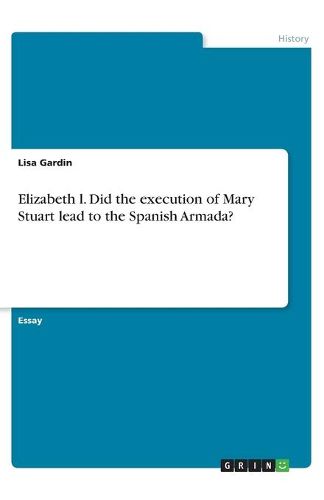Readings Newsletter
Become a Readings Member to make your shopping experience even easier.
Sign in or sign up for free!
You’re not far away from qualifying for FREE standard shipping within Australia
You’ve qualified for FREE standard shipping within Australia
The cart is loading…






Essay from the year 2017 in the subject History - Miscellaneous, grade: University, University of Luxembourg, language: English, abstract: The following essay aims to provide an understanding of religious relations and the rivalry between Elizabeth and Mary Stuart, Queen of Scots, as well as Philip II, King of Spain. In order to do so, it is essential to deliver a suiting context in addition to a thoroughly analysis on the development of these relations. To facilitate this task it is necessary to set up a central question, which will guide the assignment. Our central question is: Did the execution of Mary Stuart lead to the Spanish Armada? Finally, a conclusion will sum up the main points of this essay and give a final perspective on the central question. The enigmatic Virgin Queen, Elizabeth I of England, left many questions unresolved, particularly in regard to religion. Elizabeth was the "saviour" of Protestantism, together with her rise to the throne; she established it as the state religion as of today. She put in place an uncompromisingly Protestant Church in parliament, of which she became the Supreme Governor. Actually, it was a return to her brother's, Edward VI, settlement. However, five hundred years ago, this religious change provoked a lot of irritation and anger among Catholics within and without England. During this time, many people ardently supported Roman Catholicism, as did Elizabeth's half-sister, Mary Tudor and Elizabeth's cousin Mary Stuart, Queen of Scotland. Consequently, as supporter of Protestantism, Elizabeth I made herself numerous enemies throughout her reign and England was constantly on the brink of a religious war. Thus, even her cousin Mary Stuart, became unavoidably her rival. When Elizabeth became queen in 1558, on the death of her half-sister Mary, she inherited a country in which there was deep religious division. With Elizabeth l's ascension to the throne, England was now a Protestant nation. Yet, many Catholics in England
$9.00 standard shipping within Australia
FREE standard shipping within Australia for orders over $100.00
Express & International shipping calculated at checkout
Essay from the year 2017 in the subject History - Miscellaneous, grade: University, University of Luxembourg, language: English, abstract: The following essay aims to provide an understanding of religious relations and the rivalry between Elizabeth and Mary Stuart, Queen of Scots, as well as Philip II, King of Spain. In order to do so, it is essential to deliver a suiting context in addition to a thoroughly analysis on the development of these relations. To facilitate this task it is necessary to set up a central question, which will guide the assignment. Our central question is: Did the execution of Mary Stuart lead to the Spanish Armada? Finally, a conclusion will sum up the main points of this essay and give a final perspective on the central question. The enigmatic Virgin Queen, Elizabeth I of England, left many questions unresolved, particularly in regard to religion. Elizabeth was the "saviour" of Protestantism, together with her rise to the throne; she established it as the state religion as of today. She put in place an uncompromisingly Protestant Church in parliament, of which she became the Supreme Governor. Actually, it was a return to her brother's, Edward VI, settlement. However, five hundred years ago, this religious change provoked a lot of irritation and anger among Catholics within and without England. During this time, many people ardently supported Roman Catholicism, as did Elizabeth's half-sister, Mary Tudor and Elizabeth's cousin Mary Stuart, Queen of Scotland. Consequently, as supporter of Protestantism, Elizabeth I made herself numerous enemies throughout her reign and England was constantly on the brink of a religious war. Thus, even her cousin Mary Stuart, became unavoidably her rival. When Elizabeth became queen in 1558, on the death of her half-sister Mary, she inherited a country in which there was deep religious division. With Elizabeth l's ascension to the throne, England was now a Protestant nation. Yet, many Catholics in England